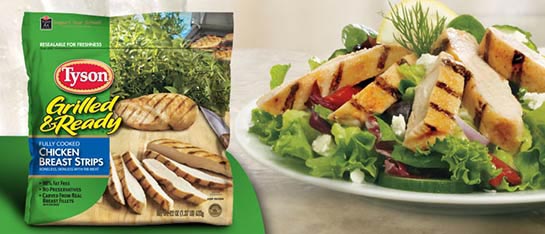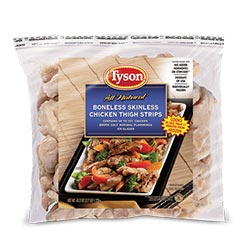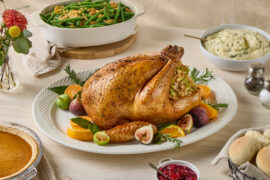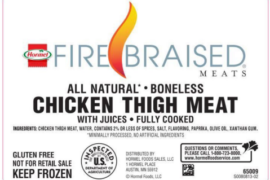The value of Tyson Foods stock rose $0.41 per share on February 8, after soaring by 7% and then falling two days before, and rebounding on February 7. When the final bell rang as the New York Stock Exchange closed late on Wednesday afternoon, the share price stood at $65.06.
The sharp rise came during pre-market trading on Monday in advance of the Springdale, Arkansas-headquartered company announcement of record results during the first quarter, as earnings increased 38%. Then came news that the US Security and Exchange Commission (SEC) had subpoenaed the company in connection with a chicken price fixing probe. When the NYSE business day was over the stock closed at $63.13, down from a high of $70.50 reached prior to the opening bell.
“We are cooperating with the investigation, which is at an early stage,” said the company in a statement. “Based upon the limited information we have, we believe the investigation is based upon the allegations in In re Broiler Chicken Antitrust Litigation.”
The lawsuit, filed by food distributer Maplewood Farms last September, alleges that from as early as January of 2008 Tyson, Pilgrims Pride, Sanderson Farms and a number of other companies “conspired and combined to fix, raise, maintain and stabilize the price of broilers” by manipulating the Georgia Dock benchmark index. This complaint was subsequently followed by a class action suit from shareholders.
Thus far it would appear that many professional Wall Street watchers, as well as share buyers, are discounting the potential downside of the lawsuits in the long term.
“We continue to believe that chicken price-fixing allegations are unfounded,” opined Jefferies analyst Akshay Jagdale. While noting that the SEC investigation could negatively impact Tyson shares in the short term, it was pointed out that the company’s “value-added earnings stream remains significantly undervalued” at an approximate “31% discount to large-cap branded packaged food peers.”
The figures released by Tyson Foods on February 6 speak loudly, as the company’s quarterly profit climbed 28.6%, helped by higher exports of beef and pork and lower livestock costs. Net income rose to $593 million, or $1.59 per share, in the first quarter that ended on December 31, from $461 million, or $1.15 per share, a year earlier. Sales rose marginally to $9.18 billion from $9.15 billion.
Best Start in Company History
 “The year is off to the best start in company history with record earnings, record operating income and record cash flows,” said Tom Hayes, president and chief executive officer of Tyson Foods. “Return on sales for each operating segment was in or above the normalized range. The tremendous returns generated in the Beef and Pork segments are providing fuel for growth in our value-added Chicken and Prepared Foods segments.”
“The year is off to the best start in company history with record earnings, record operating income and record cash flows,” said Tom Hayes, president and chief executive officer of Tyson Foods. “Return on sales for each operating segment was in or above the normalized range. The tremendous returns generated in the Beef and Pork segments are providing fuel for growth in our value-added Chicken and Prepared Foods segments.”
Tyson again led retail food manufacturers in both sales volume and sales dollars for the 13-week period corresponding with its fiscal first quarter. Not only did it lead in sales volume, according to IRI, it was the only company to show volume growth among the top 10 branded food companies operating I the US market.
“Due to our outstanding performance in Beef and Pork and strong market conditions in the first quarter, we are raising our annual earnings guidance to $4.90-5.05 per share,” said Hayes. “We expect the earnings cadence for the remainder of the fiscal year to follow more normal patterns, including the seasonality typical of our second quarter.

Summary of Segment Results
- Chicken: Sales volume increased as a result of better demand for poultry products, partially offset by a decrease in rendered product sales. The average sales price increased as a result of sales mix changes, which offset general market price declines. Operating income decreased due to increased marketing, advertising and promotion spending and higher operating costs, which included $23 million of compensation and benefit integration expense. Feed costs decreased $20 million during the first quarter of fiscal 2017.
- Beef: Sales volume increased due to improved availability of cattle supply and stronger domestic and export demand for beef products. The average sales price fell due to higher domestic availability of beef supplies and lower livestock cost. Operating income increased due to more favorable market conditions as revenues were maximized relative to the decline in live fed cattle costs, partially offset by higher operating costs.
- Pork: Sales volume increased due to strong demand for pork products and increased exports. Live hog supplies increased, which drove down livestock cost and average sales price. Operating income increased as revenues were maximized relative to the live hog markets, partially attributable to stronger export markets and operational and mix performance, which were partially offset by higher operating costs.
- Prepared Foods: Sales volume increased due to improved demand for frozen and chilled prepared foods products. The average sales price decreased primarily due to a decline in input costs of approximately $100 million, partially offset by product mix changes. Operating income decreased due to higher operating costs at some facilities, increased marketing, advertising and promotion spend and $22 million of compensation and benefit integration expense.
 Additionally, Prepared Foods operating income was positively impacted by $127 million in synergies, of which $32 million was incremental synergies in the first quarter of fiscal 2017 above the $95 million of synergies realized in the first quarter of fiscal 2016. The positive impact of these synergies to operating income was partially offset with investments in innovation, new product launches and supporting the growth of brands.
Additionally, Prepared Foods operating income was positively impacted by $127 million in synergies, of which $32 million was incremental synergies in the first quarter of fiscal 2017 above the $95 million of synergies realized in the first quarter of fiscal 2016. The positive impact of these synergies to operating income was partially offset with investments in innovation, new product launches and supporting the growth of brands.
Outlook
In fiscal 2017, the United States Department of Agriculture (USDA) indicates domestic protein production (chicken, beef, pork and turkey) should increase approximately 2-3% from fiscal 2016 levels and moderate export growth. As Tyson continues with the integration of Hillshire Brands, the company expects to realize synergies of around $675 million in fiscal 2017 from the acquisition as well as its profit improvement plan for legacy Prepared Foods business with some incremental synergies expected to be realized in fiscal 2018. The majority of these benefits will be realized in the Prepared Foods segment.
The following is a summary of the outlook for each of the segments, as well as an outlook on sales and capital expenditures.
- Chicken: USDA shows an increase in chicken production of approximately 2% in fiscal 2017 as compared to fiscal 2016. Based on current futures prices, Tyson expects similar feed costs in fiscal 2017 as compared to fiscal 2016. For fiscal 2017, the Chicken segment’s operating margin should be at the upper end of its normalized range of 9-11%.
- Beef: Tyson anticipates industry fed cattle supplies to increase approximately 3-4% in fiscal 2017 as compared to fiscal 2016. The company generally expects adequate supplies in regions its plants operate. For fiscal 2017, the Beef segment’s operating margin should be around 5%.
- Pork: It is expected that industry hog supplies will increase approximately 3-4% in fiscal 2017 as compared to fiscal 2016. For fiscal 2017, the Pork segment’s operating margin should be around 12%.
- Prepared Foods: Tyson forecasts that input costs will be flat for the remainder of fiscal 2017 as compared to fiscal 2016. For fiscal 2017, operating margins are expected to be a little below fiscal 2016 as investments are made in innovation and growth of brands as well as in facilities to enable operational improvements and cost efficiencies.
- Other: This includes foreign operations related to raising and processing live chickens in China and India, third-party merger and integration costs and corporate overhead related to Tyson New Ventures, LLC. The expectation is that the operating loss should be approximately $70 million in fiscal 2017.
- Sales: Tyson expects sales to be flat compared to fiscal 2016, as it grows sales volume across each segment, offset by the impact of lower beef prices.
- Capital Expenditures: The company anticipates capital expenditures to approximate $1.0 billion for fiscal 2017. This will include spending for production growth, safety, animal well-being, infrastructure replacements and upgrades, and operational improvements that will result in production and labor efficiencies, yield improvements and sales channel flexibility.





